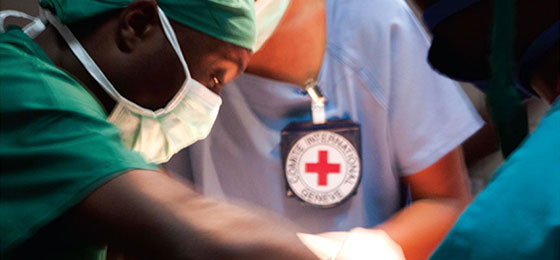A Field Guide—Management of Limb Injuries
April 23, 2019
The launch of the handbook, Management of Limb Injuries during Disasters and Conflicts took place at the ICRC (International Committee of the Red Cross) Headquarters in Geneva. This work is the result of collaboration between the ICRC and the WHO’s EMT (Emergency Medical Teams) Initiative, made possible by a grant from the AO Foundation. The objective of the field guide is to improve outcomes of patients suffering severe limb injury in disasters and complex emergencies. It offers clear practical guidance to international surgical teams in situations that differ hugely from their normal daily practice. The handbook is an easy-to-read, hands-on guide developed based on the consensus of 30 authors from the ICRC, WHO and the AO Foundation each of who bring special and personal expertise to the project.
Chief Surgeon ICRC Dr Harald Veen outlined the background of the collaboration and introduced the President of the ICRC, Peter Maurer who placed the project in the context of today's humanitarian work. Up to 90% of the surgical workload faced by national and international emergency medical teams in disasters involves limb injury. But as medical science improves and trauma rates decrease in high-income countries, well-intentioned surgical teams can find themselves unprepared for the realities of austere settings. This handbook will provide clear practical guidance on safe and effective limb-injury care in conflicts or disasters. Maurer furthermore emphasized the power of collaboration between the humanitarian organizations to impact solid standards of treatment that is evident in this project.
Representing the WHO, Ian Norton, EMT Lead of the WHO, recalled the concerns of the humanitarian community that the world had largely failed in its efforts to provide life- and limb-saving care following the Haiti earthquake. Many of the teams arriving on the ground were unable to provide care that truly met the needs of the population they hoped to serve. They were unfamiliar not only with the emergency-response system and standards, but also with the particular challenges of providing care in extremely austere environments. This situation led to the WHO EMT Initiative, which in 2013 published the Classification and Minimum Standards for Foreign Medical Teams in Sudden Onset Disasters.
Ambassador Toni Frisch, Chairman of the Strategic Advisory Group of the WHO EMT initiative was the next to the podium and expressed his sincere thanks to all involved for this important development that thinks beyond natural disasters, also addressing conflict situations that are an issue increasingly in today's society. Dr Johan von Schreeb from the Karolinska Institute, Stockholm spoke about the content of the field guide, its practical relevance and basis in the "pragmatic evidence" of the authors' consolidated experience.
AO Foundation President, Dr Nikolaus Renner explained the importance to the AO of its involvement in this project. According to Renner, "every time a disaster occurred in the past our surgeon community urged us to help in some way. However, the ideas how the AO Foundation best could contribute to the relief were quite controversial. We therefore established a small taskforce chaired by Prof David Helfet and at a first meeting during the Davos courses 2013 it became quite clear that it would be naïve to believe that the AO should create and deploy its own AO Disaster Relief Team since the initial challenges are primarily the safety and the logistics. However, as the first-in-class provider of education in the field of trauma and orthopedics the AO Foundation could contribute its profound expertise in this field. A first step led now to the development of the actual field guide for the management of lower limb injuries. The cooperation with the WHO and the ICRC and its experts in this project ensures the relevance of the content and opens up important new channels for the dissemination". Urs Rüetschi, Director AO Education Institute provided an outlook for the future of the project. The AO will create open-source educational resources and e-learning modules that will be made available over the next two years on a dedicated web platform for use by members of Emergency Medical Teams and disaster course providers. The website, launched by the AO on December 16, so far contains the complete, and individual, chapters of the field guide for download and an initial collection of instructional videos and further resources. A range of educational elements will be added to over the next 24 months.
Management of Limb Injuries is the outcome of a project initiated at a workshop chaired by the AO and co-chaired by WHO and the ICRC at the AO headquarters in Davos in December 2015. This was a consensus meeting focused on developing global expert consensus documents and open access education materials to improve the care of patients with wounds and orthopedic injuries suffered during disasters and complex emergencies. The project milestone agreed during this workshop to create a minimum standards document for the care of people with limb injuries in disasters and complex emergencies, freely accessible, which addresses controversies in limb care during disasters and conflicts in the form of a field guide to initial management has now been successfully achieved with this launch.
Contact
Please contact the Strategy Fund team at strategyfund@aofoundation.org


